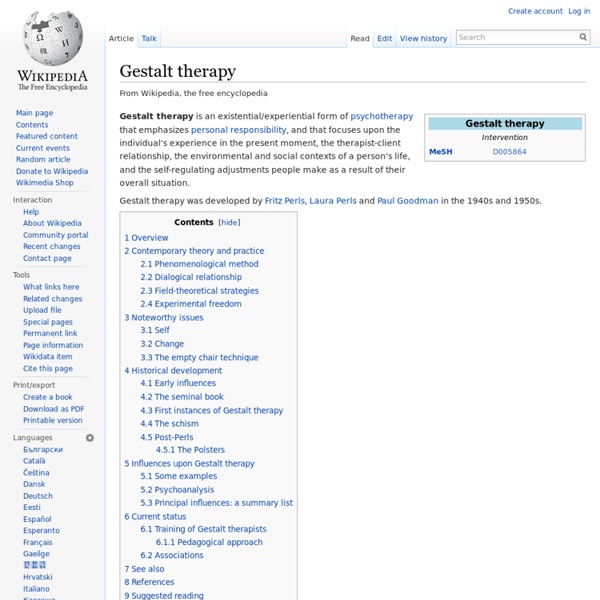Feldenkrais wiki
Feldenkrais illustrating the function of the human skeleton in sitting. The Feldenkrais Method, often referred to simply as "Feldenkrais", is a somatic educational system designed by Moshé Feldenkrais (1904–1984). Feldenkrais aims to reduce pain or limitations in movement, to improve physical function, and to promote general wellbeing by increasing students' awareness of themselves and by expanding students' movement repertoire. Approach[edit] Feldenkrais taught that increasing a person's kinesthetic and proprioceptive self-awareness of functional movement could lead to increased function, reduced pain, and greater ease and pleasure of movement. The Feldenkrais Method, like the Alexander Technique, is therefore a movement pedagogy as opposed to a manipulative therapy. Moshé Feldenkrais (pictured bottom) practising Judo, one of the major influences on his work. Feldenkrais is used to improve movement patterns rather than to treat specific injuries or illnesses. Scientific studies[edit]
Alexander wiki
The Alexander technique, named after Frederick Matthias Alexander, teaches people how to stop using unnecessary levels of muscular and mental tension during their everyday activities. It is an educational process rather than a relaxation technique or form of exercise. The Alexander technique has been shown to be helpful for back pain and Parkinson's.[1] There is insufficient evidence to determine if it has any effect in asthma.[2] Practitioners say that such problems are often caused by repeated misuse of the body over a long period of time, for example, by standing or sitting with one's weight unevenly distributed, holding one's head incorrectly, or walking or running inefficiently. The purpose of the Alexander technique is to help people unlearn maladaptive physical habits and return to a balanced state of rest and poise in which the body is well-aligned.[3] History[edit] Alexander was a Shakespearean orator who developed voice loss during his performances. Process[edit] End-gaining
Rubenfeld Synergy Method
Unergi Body-Psychotherapy with Ute Arnold
Total Clarity Counseling
Cindy Foss Body Psychotherapist, Reiki Master Clinical Member of the United States Association of Body Psychotherapy Co-Founder of The Suppers Programs Body Psychotherapist "In my own practice, I love the experience of facilitating and witnessing others gain self-awareness and self-empowerment as they move through the process of making distinctions and deepening their connections with their mental, emotional, physical and spiritual selves." “The Clinical membership is for those who are practicing body psychotherapists and have the following qualifications: […] certification from a recognized body psychotherapy training program and training in formal principles of psychotherapy.” “[…] The training in and experiencing of a specific body psychotherapy modality or method is one of the most important criterion according to many body psychotherapists.” The intent of this training was to learn from the inside out, incorporating the body with the here-and-now experience. Reiki Master
The Suppers Programs
Feldenkrais clip
Gestalt clip
How does craniosacral therapy work? - by Dr Pandula Siribaddana
Dr Pandula Siribaddana's image for: "How does Craniosacral Therapy Work" Caption: Location: Image by: Craniosacral therapy is a form of alternative medical treatment for symptoms related to the head and neck, the spine and the back. History of craniosacral therapy William Garner Sutherland first introduced it to the medical community in 1899 and since its introduction; it has become a popular practice among osteopaths, massage therapists, naturopaths and chiropractors. The process of craniosacral therapy According to the practitioners of craniosacral therapy, the practice centers around the biodynamic of the cerebrospinal fluid. The guidelines When looking at the actual process of craniosacral therapy, each session is expected to last around one hour. The adverse effects In any event, the procedure is generally safe although there were few instances of adverse outcomes when craniosacral therapy tried to intervene at the time of traumatic brain syndrome. Conclusion
Craniosacral Therapy with Debra Morrice
I expend a lot of effort in my life at the moment. Not a building-a-pyramid, digging-a-coal-mine kind of effort, you understand. It's not like I'm going to come down with black lung anytime soon. Words come to me with ease, and I don't have trouble articulating my quandaries and concerns, to hash out my freak outs. So I seek release in non-verbal ways. And as much as I love yoga, in my toughest times, even that is an effort. In the whimsically emotional Michel Gondry film, Kate Winslet and Jim Carey's characters submit to a quirky treatment to wipe out sad memories holding them back. Here's where Debra Morrice's craniosacral therapy comes in. I first stumbled onto Debra's craniosacral therapy (CST) at a trial offer at my London yoga studio last month. At the best of times, I present a challenge for body workers. As a longtime devotee of deep-tissue massage, I wasn't sure if I would even “feel” CST. She laughed and shook her head. “The body will let go of what it's ready to let go of.
Tensegrity correction eases chronic headache
A woman in her sixties had been consulting me for craniosacral treatment for headaches. For 20 years she had been suffering from debilitating head pain which had not responded to conventional or complementary approaches, including acupuncture and massage. Her headaches responded to the release of compression in her occipital bone. She experienced almost complete relief by the fourth treatment. Although she was very pleased, I noticed that there was still a degree of hypertonicity in the cervical musculature contributing to some residual discomfort. This illustrates three things: firstly, patients forget important aspects of their history; secondly, what may seem trivial may be a maintaining factor in a pattern of dysfunction and thirdly, the interconnectedness of the body. A modern way of explaining this is to view the organism as a tensegrity structure. Tensegrity can be disturbed by trauma or ageing. All this for just $7.27. Written for Choice Health Mag. Like this: Like Loading...



